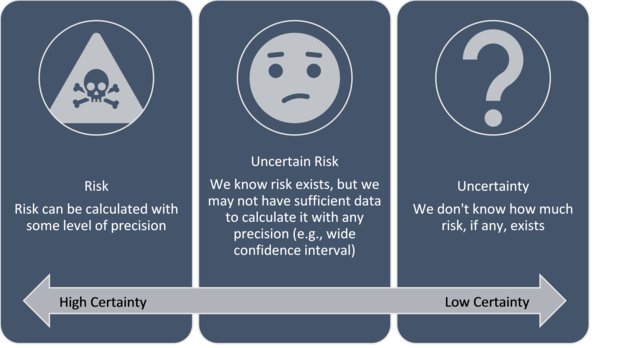Heuristics
Costs, Benefits, and Risks: The Importance of Tradeoffs
Failing to balance tradeoffs effectively can result in decisions we regret.
Posted June 17, 2020

We make an extraordinary number of daily decisions, ranging from those made without much conscious thought (such as deciding to get out of bed) to those made with much more consideration (such as deciding whether to buy a new house). Most of these decisions are heavily influenced by how we weight costs, benefits, and risks. I will discuss the role of each of them, but there are some points I want to clarify before I do.
First, there’s a difference between the objective existence of costs, benefits, and risks and how we subjectively perceive them. In some cases, our perceptions are accurate, but in others, like when we demonstrate some types of cognitive biases (such as loss aversion, anchoring, or negativity bias), our perceptions are over- or under-inflated. We may also fail to perceive existing costs, benefits, or risks or perceive some that don’t actually exist. The more our subjective perception aligns with objective reality, the less likely we are to make errors that detract from the quality of our decision.
This means our decisions are influenced by the costs, benefits, and risks we perceive as salient (those we perceive as important enough to consider[1]); and we weight them[2] based on our subjective assessments. Consider parents who believe that vaccines cause autism. They perceive a vaccination health risk, despite the objectively greater risk of ill health if their children aren’t vaccinated. This leads them to overestimate vaccination risk and underestimate the risk of disease, a decision that is inconsistent with objective risk data.
Second, short- and long-term costs, benefits, and risks may differ. For example, buying a house often requires different short-term costs (e.g. closing costs, time, and energy to house hunt) than long-term costs (e.g., mortgage, taxes, utilities, maintenance, time and energy to clean). Depending on the situation, we may be more focused on short-term implications at the expense of long-term implications, which may lead to unintended consequences.
With that clarification, it is easier to explain the way costs, benefits, and risks help shape our decisions.
Costs
Costs are the resources a specific choice demands, such as time, energy, or money. The decision to go to the grocery store, for example, requires time, energy, and transportation costs. The decision to put together a shopping list before going requires time and energy. Which items end up on the shopping list may be impacted by consideration of the shorter-term financial costs to purchase those items as well as the longer-term costs of time and energy that may go into making specific meals.
Therefore, even an act as simple as grocery shopping possesses a lot of potential cost considerations. How much we consider any of them, though, may vary based on the situation. For example, we may be more conscious about the financial costs of what we buy if it has been a tight month financially than if it hasn’t. We might also be more conscious about the time and energy costs of the meals we plan to make when we have a busy week ahead.
Costs generally do not exist in a vacuum, though. In most cases, we evaluate them relative to the benefits we foresee.
Benefits
Benefits are the gains or rewards that may result from different decisions. In sticking with our grocery store example, we benefit from obtaining food, especially food we enjoy. There’s obviously the nutritional benefit, but there’s also the emotional benefit from eating what we find delicious and having access to a plethora of food choices.
Benefits may be short term and/or long term in nature. In some cases, we may forego a short-term benefit to derive a greater benefit later (such as with anything we view as an investment). In other cases, we may prioritize a short-term benefit (such as splurging on a meal at an expensive restaurant), even if it means we may not benefit as much (or at all) in the long run (less money to spend the rest of the month)[3].
Benefits seldom exist in the absence of costs, even if those costs are minimal. For many decisions, we assume the probability of the costs leading to the expected benefit is 100%. If that were the case, it would make our decision simply a matter of balancing costs and benefits. Few decisions, though, are 100% likely to bring about the expected benefit, which means we also must consider risk.
Risks
Risk exists when there is less than a 100% probability that the resources we invest will produce the expected benefit or, worse, when there is some probability that we will bring about a different, and possibly unexpected, negative outcome. We generally expect that if we expend the costs required to go to the grocery store, we’ll experience the benefits that come with it. However, there is a small risk that something bad will happen to us while we’re gone (such as having a car accident or getting mugged). Therefore, it isn’t 100% likely that we’ll receive the benefits we expect, though the probability may still be extraordinarily high[4].
Prior to the onset of COVID-19, most of us didn’t consciously evaluate the risk of grocery shopping before doing so. Yet, now, many people give more conscious thought to the potential risk of acquiring COVID-19 when they go due to the increased salience of that risk[5].
Newly identified risks, recent negative experiences, and traumatic events[6] may all make various risks more salient. When that happens, we tend to be more deliberative about those risks but also more likely to overestimate their probability. Overestimation may cause us to engage in more extreme choices to minimize risks, leading to a form of loss aversion[7].
Once risks become less salient, they tend to operate in the background, sometimes leading us to automatize behaviors consistent with the goal of risk reduction[8], such as putting on a seat belt. Other times, we may behave as if the risk is minimal or nonexistent, such as any situation where we become careless because nothing bad has ever happened.
It is also important to differentiate risk from uncertainty, as I do in Figure 1. To illustrate, consider risks that might exist when starting a new business. As of June 2020, the current state of the economy presents some risks to that endeavor, some of which are new. However, we don’t know whether the same amount of risk will exist in the future, and this leads to uncertainty. The farther into the future we try to foresee, the more difficult it is for us to account for objective risk.

Risk adds nuance to decision-making approaches. Most of the time, clear risk probabilities aren’t easily calculated, and even if they are, those probabilities usually cannot account for factors that may increase or decrease actual risk probability in a given situation[9]. We are, therefore, left to make trade-offs between costs and benefits, with our assessment of these trade-offs being influenced by salient risk perceptions.
The Complicated Nature of Tradeoffs
Many decisions come down to one of the following:
- Do the costs (the salient ones) required to do X justify the likely probability (based on salient risks) that we will receive Y benefits (salient short- and/or long-term)?
- Am I willing to expend the resources (salient costs) for the probability (accounting for salient risks) of obtaining X (salient short- and/or long-term benefits[10])?
It is important to note that we don’t necessarily engage in complex mathematical reasoning to reach a decision, nor when choosing among multiple options do we necessarily choose the one that would be evaluated as the best choice using such reasoning. Instead, as Herbert Simon argued, we tend to make decisions based on a “good enough” standard, what he referred to as a satisficing[11] decision.
For many decisions we make unconsciously, we don’t necessarily factor in a lot of salient risk. We just assume that if we expend the resources to do something, we’ll get some benefit in return. If we do factor in salient risk, we may develop automatized behaviors based on risk-adjusted decisions (such as washing our hands after handling raw meat or locking our doors when we exit our vehicle). These assumptions, with or without risk adjustments, become part of the heuristics we use to guide our behavior.
For more conscious decisions or in less routine environments, we may rely both on existing heuristics and situation-specific information to make our decisions. For example, some drivers are more liberal with their speed choice only in specific situations (situation-adjusted heuristics), whereas other drivers either speed regularly or seldom speed (situation-stable heuristics)[12]. Thus, while we may have some heuristics that generally govern our behavior, situation-specific factors often affect the salience of, and weight we assign to, existing heuristic-driven cost, benefit, or risk perceptions. This explains why we make drastically different choices in some situations than in others, even if the situations are comparable. Small, but salient, situational differences can cause heuristic adjustment, leading to different decisions. How well our heuristic-driven assessments align with objective reality, though, will help determine if we’ve made a good decision.
References
[1] Whether they do or don’t actually exist.
[2] This weighting is often not a conscious process.
[3] Many of these cases involve trade-offs we make, as I discuss below.
[4] Often high enough that it doesn’t cause us to consider the risks.
[5] We may not know exactly what that risk is, but we certainly know there is some level of risk. Whether or not that leads to changes in people’s behavior likely concerns how high they perceive that risk to be.
[6] In terms of our grocery store example, Covid-19 would fall into the category of newly identified risks; having a car accident the last time you went to the store would be an example of a recent bad experience, and having been the victim of a violent crime while leaving the grocery store at some point in the past would be an example of a traumatic event.
[7] It doesn’t necessarily mean we won’t choose that option. It simply means we may take additional steps to minimize risk. In the case of COVID-19, this may mean wearing a high-quality mask and latex gloves, carrying hand sanitizer, and ensuring you maintain extreme social distancing if going out in public.
[8] Sometimes, though, our attempts at risk reduction may not have their intended effects, such as in the case of parents opting out of vaccinating their children.
[9] For example, the probability of dying in a car accident is 1 in 114. Yet, in any given situation that probability is likely higher or lower depending on a variety of factors (such as driver competence, driver BAC level, road conditions, time of day, driver fatigue).
[10] Focusing only on short-term benefits may increase the risk of long-term negative consequences.
[11] It represents a combination of satisfy and suffice. Hence, a satisficing decision could be considered one that is sufficiently satisfactory.
[12] https://www.theregreview.org/2012/09/06/6-mckenna-speeding/




